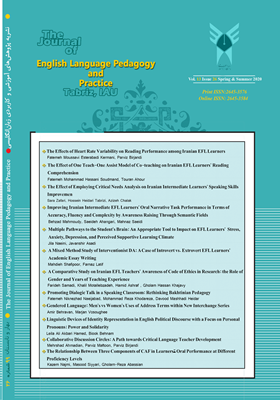Multiple Pathways to the Student’s Brain: An Appropriate Tool to Impact on EFL Learners’ Stress, Anxiety, Depression, and Perceived Supportive Learning Climate
محورهای موضوعی : English Language Teaching (ELT)ژیلا نائینی 1 , جوانشیر اسدی 2 , نسرین سادات اعظمی 3
1 - گروه روانشناسی، واحد گرگان، دانشگاه آزاد اسلامی، گرگان، ایران
2 - گروه روانشناسی، واحد گرگان، دانشگاه آزاد اسلامی، گرگان، ایران
3 - گروه بیولوژی، واحد گرگان، دانشگاه آزاد اسلامی، گرگان، ایران
کلید واژه:
چکیده مقاله :
The impetus behind the current study was to get the best use of all possible pathways of the learner’s brain. Multiple-pathway model, one model of brain-based instruction, on which the current study was based, has synergic effect addressing sensory-motor, emotion, reward, attention, memory, language, frontal lobe (executive function), and social pathways of the learner’s brain altogether. To this aim, this quasi-experimental research, with pretest-intervention-posttest design, was carried out. The participants, who were selected through a convenient sampling method, included 30 BA University students studying TEFL at Islamic Azad University, Aliabad Katoul Branch, and 30 BA University students studying TEFL at Islamic Azad University, Gorgan Branch, were placed into two experimental and control groups, respectively. The instrumentation included DASS 21 and Learning Climate Questionnaires (LCQ) which were used as the pretest and posttest prior to and after the 10 session intervention of brain-based instruction for the experimental group. Descriptive and inferential analysis of collected data indicated the significant impact of the instruction on the participants’ stress, anxiety, depression, and perceived supportive learning climate in the experimental group.
هدف پژوهش حاضر، بررسی اثربخشی آموزش مغز ـ محور بر استرس، اضطراب، افسردگی و فضای حمایتی ادراکشده فراگیران زبان انگلیسی در استان گلستان بود. برای اجرای این پژوهش، از طرح پژوهشی نیمهآزمایشی همراه با پیشآزمون ـ مداخله ـ پسآزمون با گروه کنترل، استفاده شد. جامعه آماری آن، دانشجویان کارشناسی آموزش زبان انگلیسی استان گلستان بودند. برای نمونه آماری، 30 دانشجوی آموزش زبان انگلیسی دانشگاه آزاد واحد علیآباد کتول، بهکمک روش نمونهگیری در دسترس، انتخاب و گروه آزمایش نامگذاری شدند و30 دانشجوی آموزش زبان انگلیسی نیز از واحد گرگان انتخاب شدند و گروه کنترل نام گرفتند. ابزار پژوهش، پرسشنامههای استرس، اضطراب و افسردگی، لاویبوند و لاویبوند (1995) (DASS21) و پرسشنامه فضای حمایتی ادراکشده (ویلیام و دسی، 1996) بود و بهعنوان پیشآزمون و پسآزمون قبل و بعد از مداخله، در گروههای آزمایش و کنترل (بدون مداخله) استفاده شدند. برای مداخله، گروه آزمایش با بهرهمندی از مدل گذرگاه چندگانه زدینا (2014) در 10 جلسه تحت آموزش مغز ـ محور قرار گرفت. گذرگاههای چندگانه مغزی مدل زدینا، گذرگاه حسی ـ حرکتی، گذرگاه عواطف، گذرگاه پاداش، گذرگاه توجه و حافظه و گذرگاه لب پیشانی هستند. هر جلسه آموزشی بر تمرینها و روشهایی متمرکز بودند که با گذرگاه خاصی از مغز ارتباط داشتند. پیشآزمون (پرسشنامهها) در ابتدای ترم آموزشی بهطور آنلاین برای هر دو گروه ارسال شد و پسآزمون (همان پرسشنامهها) نیز، بعد از 10 جلسه، بار دیگر در اختیار هر دو گروه قرار گرفت. تحلیل دادهها حاکی از اثربخشی آموزش مغزـ محور بر استرس، اضطراب، افسردگی و فضای حمایتی ادراکشده فراگیران زبان انگلیسی استان گلستان بود.


